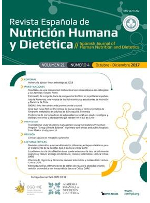Knowledge about Pesticides Use and Consumption of Fruit and Legumes in Growers and Consumers in the Province of Nador, Morocco. Results from a Survey Study.
DOI:
https://doi.org/10.14306/renhyd.26.4.1708Keywords:
Pesticides, Pesticides Residues, Pesticide Exposure, Risk AssessmentAbstract
Introduction: Pesticides are increasingly used in agriculture to protect crops against diseases, insect pests, weeds, etc. Pesticides leave residues and chemical active material, which can affect the health of consumers. Several epidemiological studies have demonstrated a link between pesticide residues in fruits and vegetables and disease infestations in humans and problems related to sterility, allergies, and even carcinogenic diseases. Consumer awareness and the application of strict legislation about the application of pesticides in agriculture remain as a good alternative to face this issue.
Methods: This survey was carried out in the region of Nador, North-East of Morocco. It is a quantitative study of a representative sample made up of 100 consumers and 50 farmers in relation to fruit and vegetables and the use of pesticides.
Results: Most consumers are not aware of the danger of pesticides and residues in fruits and vegetables. In addition, the survey revealed that potato, tomato, apples, and bananas are the most consumed. These foods are usually characterized by a high rate of application of pesticides and with a higher rate of pesticides residues. In addition, surveys carried out in farmers, revealed that they consider the economic and agronomic interest of the application of these pesticides without considering the residual effects on health. Moreover, a high rate of sterility was observed among these surveyed farmers (31%).
Conclusions: The consumers are less aware of the danger of pesticides. The choices of farmers are only accentuated on the aspect of economic use of these products and not on the health and environment.
References
(1) Matthews GA. A History of Pesticides. CABI International. 2018.
(2) Tronsmo AM, Collinge, DA, Djurle A, Munk L, Yuen J, Tronsmo A. Plant pathology and plant diseases. CABI International. 2020.
(3) Schoonhoven LM, Joop Loon, JA, Dicke M. Insect-plant biology. Oxford University Press, 2nd edition. 2006.
(4) Zimdahl R. Fundamentals of weed science, 5th Edition. Academic Press, Elsevier. 2018.
(5) Upadhyay, S. K. , Singh, S. P. . Molecules and Methods for the Control of Biotic Stress Especially the Insect Pests — Present Scenario and Future Perspective. In: Shanker, A. K. , Shanker, C. , editors. Abiotic and Biotic Stress in Plants - Recent Advances and Future Perspectives. London: IntechOpen; 2016. 10.5772/62034
(6) Uram C. International regulation of the sale and use of pesticides. Northwestern Journal of International Law and Business. 1990;10(3): 460-478.
(7) World Health Organization. L’utilisation des pesticides en agriculture et ses conséquences pour la santé publique. Genève. 1991.
(8) Shimshoni JA, Bommuraj V, Chen Y, Sperling R, Barel S, Feygenberg O, et al. 2020. Postharvest fungicide for avocado fruits: antifungal efficacy and peel to pulp distribution kinetics. Foods. 2020;9:124. 10.3390/foods9020124.
(9) Akashe M, Pawade U, Nikam A. Classification of pesticides: a review. International Journal of Research in Ayurveda and Pharmacy. 2018;9:144-150. 10.7897/2277-4343.094131
(10) Kaur R, Mavi GK, Raghav S. Pesticides Classification and Its Impact on Environment. International Journal of Current Microbiology and Applied Sciences. 2019;8(3):1889-1897. 10.20546
(11) Sarker A, Akbor MA, Nahar A Hasan M Towfiqul Islam AR, Abu Bakar Siddique M. Level of pesticides contamination in the major river systems: A review on South Asian countries perspective, Heliyon. 2021;7(6):12p. 10.20546.
(12) Mwabulambo SG, Mrema EJ, Ngowi AV Mamuya S. Health symptoms associated with pesticides exposure among flower and onion pesticide applicators in Arusha Region. Annals of Global Health. 2018;84(3):369-379. 10.29024/aogh.2303.
(13) Thabet H, Brahmi N, Kouraïchi N, Elghord H, Amamoub M. Intoxications par les pesticides organophosphorés: nouveaux concepts Réanimation. 2009;18: 633-639. 10.1016/j.reaurg.2009.05.006.
(14) Thany SH, Reynier P, Lenaers G. Neurotoxicité des pesticides : Quel impact sur les maladies neurodégénératives?. Médecine/sciences. 2013;29:273-8, doi:10.1051/medsci/2013293013.
(15) Nicolopoulou-Stamati P, Maipas S, Kotampasi C, Stamatis P, Hens L. Chemical pesticides and human health: the urgent need for a new concept in agriculture. Frontiers in public health. 2016;4:148. 10.3389/fpubh.2016.00148.
(16) Bedi JS, Gill JP, Kaur P, Sharma A, Aulakh RS. Evaluation of pesticide residues in human blood samples from Punjab (India).” Veterinary world. 2015;8(1):66-71. 10.14202/vetworld.2015.66-71
(17) Chiu YH, Williams PL, Gillman MW, Gaskins AJ, Mínguez-Alarcón L, Souter I, et al. Earth study team: association between pesticide residue intake from consumption of fruits and vegetables and pregnancy outcomes among women undergoing infertility treatment with assisted reproductive technology. JAMA Internal Medicine. 2018;8(1):17-26. 10.1001/jamainternmed.2017.5038.
(18) Bassil KL, Vakil C, Sanborn M, Cole DC, Kaur JS, Kerr KJ. Cancer health effects of pesticides: systematic review. Canadian Family Physician. 2007;53(10):1704-1711
(19) Yan D, Zhang Y, Liu L, Yan H. Pesticide exposure and risk of Alzheimer's disease: a systematic review and meta-analysis. Scientific Reports. 2016;6:32222. 10.1038/srep32222
(20) Hoppin JA, Umbach DM, Long S, London SJ, Henneberger PK, Blair A, et al. Pesticides are associated with allergic and non-allergic wheeze among male farmers. Environmental Health Perspectives. 2017;125(4):535-543. 10.1289/EHP315.
(21) Jeyanthiand H, Kombairaju S. Pesticide Use in Vegetable crops: frequency, intensity and determinant factors. Agricultural Economics Research Review. 2005;18:209-221. 10.22004/ag.econ.58472.
(22) Lahlali, R., Moinina, A., Ezrari, S., Maclean, D., & Boulif, M. Apple Scab Disease severity in the sais region of morocco and its sensitivity to three commercial fungicides. Notulae Scientia Biologicae. 2019;11(2):249-257.
(23) Komarek M., Cadkova E., Chrastny V., Bordas F, Bollinger JC. Contamination of vineyard soils with fungicides: a review of environmental and toxicological aspects. Environment International. 2010;36:138-151. 10.1016/j.envint.2009.10.005.
(24) Gill HK, Garg, H. Pesticides: environmental impacts and management strategies,” in Pesticides–Toxic aspects, eds S. Solenski, M L Larramenday, and L Marcelo (Norderstedt: Books on Demand). 2014;187-230. 10.5772/57399.
(25) Provost C, Pedneault K. The organic vineyard as a balanced ecosystem: improved organic grape management and impacts on wine quality. Scientia Horticulturae. 2016; 208:43-56. 10.1016/j.scienta.2016.04.024.
(26) Tsakirakis AN, Kasiotis KM, Charistou AN Arapaki N, Tsatsakis A, Tsakalof A. Dermal and inhalation exposure of operators during fungicide application in vineyards, evaluation of coverall performance. Science of the Total Environment. 2014;47:282-289. 10.1016/j.scitotenv.2013.09.021.
(27) Sungur S, Tunur C. Investigation of pesticide residues in vegetables and fruits grown in various regions of Hatay, Turkey. Food Addit Contam Part B Surveill. 2012;5(4):265-7. 10.1080/19393210.2012.704597.
(28) Epp A, Michalski B, Banasiak U, Bö GF. Pesticide residues in food. public perceptions in Germany, A Summary Report. BfR Wissenschaft, Federal Institute for Risk Assessment. Berlin. 2011.
(29) Brun S, Sauphanor G. Pesticide use in current and innovative apple orchard systems. Agronomy for Sustainable Development, Springer Verlag/EDP Sciences/INRA. 2011;31(3):541-555. 10.1007/s13593-011-0003-7.
(30) Okonya, JS, Kroschel J. A cross-sectional study of pesticide use and knowledge of smallholder potato farmers in Uganda.” BioMed Research International, 2015;759049. 10.1155/2015/759049.
(31) Raada S, Mazouz H, Boulif M. Phytosanitary practices of apple growers in the Ifrane province of the Middle Atlas of Morocco and perspectives of improvement. Revue Marocaine de Protection des Plantes. 2019;13:19-33.
(32) Lozowicka B, Abzeitova E, Sagitov A, Kaczynski P, Toleubayev, K, Li, A. Studies of pesticide residues in tomatoes and cucumbers from Kazakhstan and the associated health risks. Environmental monitoring and assessment. 2015;187(10): 609. 10.1007/s10661-015-4818-6.
(33) Mahdavi V, Eslami Z Molaee-Aghaee E, Peivasteh-Roudsari L, Sadighara P Thai VN, et al. Evaluation of pesticide residues and risk assessment in apple and grape from western Azerbaijan Province of Iran. Environmental Research. 2022;203,111882. 10.1016/j.envres.2021.111882.
(34) Pirsaheb M, Fattahi N, Rahimi R, Sharafi K, Ghaffari HR. 2017. Evaluation of abamectin, diazinon and chlorpyrifos pesticide residues in apple product of Mahabad region gardens: Iran in 2014, Food Chemistry. 2017;231:148-155. 10.1016/j.foodchem.2017.03.120.
(35) Pszczolkowski MA, Brown JJ. Enhancement of insecticides against codling moth (Lepidoptera: Tortricidae) with l-aspartate in laboratory and field experiments, Journal of Economic Entomology. 107(3):1163-1171. 10.1603/ec13446.
(36) Chatzidimopoulos M, Lioliopoulou F, Sotiropoulos T, Vellios E. Efficient control of apple scab with targeted spray applications. Agronomy. 2020;10:217. 10.3390/agronomy10020217.
(37) Falak R, Sankian M, Varasteh AR. The Possible Role of Organophosphorus Pesticides in Augmentation of Food Allergenicity: A Putative Hypothesis. Research Journal of Environmental Toxicology. 2012;6:88-100. 10.3923/rjet.2012.88.100.
(38) Neghab M, Momenbella-Fard M, Naziaghdam R, Salahshour N, Kazemi M, Alipour H. The effects of exposure to pesticides on the fecundity status of farm workers resident in a rural region of Fars province, southern Iran. Asian Pacific Journal of Tropical Biomedicine. 2014;4(4):324-328. 10.12980/APJTB.4.2014C586.
(39) Roeleveld N, Bretveld R. The impact of pesticides on male fertility. Current Opinion in Obstetrics and Gynecology. 2008;20:229-233. 10.1097/GCO.0b013e3282fcc334.
Published
How to Cite
Issue
Section
License
Copyright (c) 2020 Kamal Aberkani, Fatima Zahra Briache, Hassan Ghazal , Salah Ed-dine Samri

This work is licensed under a Creative Commons Attribution-NonCommercial-ShareAlike 4.0 International License.











